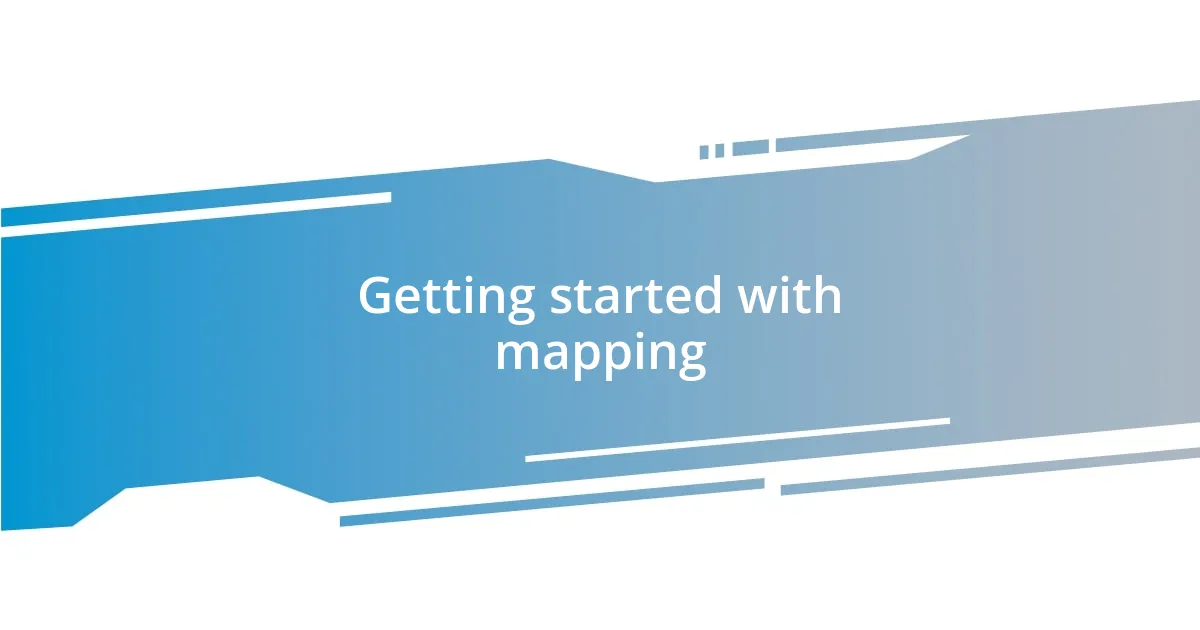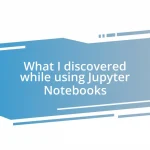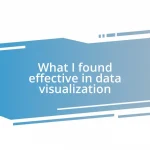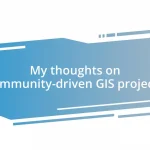Key takeaways:
- OpenStreetMap (OSM) allows anyone to contribute to a global map, enriching it with personal experiences and local knowledge.
- The platform is user-friendly, encouraging new mappers to start with small, manageable goals and gradually expand their contributions.
- Utilizing tools like JOSM and Mapillary enhances the mapping experience, helping users create more detailed and accurate maps.
- Engaging with the OSM community fosters collaboration and support, turning individual efforts into a collective mission to improve mapping for all.

Introduction to OpenStreetMap contributions
OpenStreetMap (OSM) contributions, in essence, empower individuals to map their world collaboratively. When I first stumbled upon OSM, I was intrigued by the idea that anyone could add to a global map with just a few clicks. This sense of community and shared knowledge was both exhilarating and a bit daunting—how could my small contributions really make a difference?
As I delved deeper, I learned that every tag I added or road I updated enriched the overall project. I vividly remember mapping my local park; it wasn’t just a personal project but a way to connect others with a space that held countless memories for me. Can you imagine the satisfaction of knowing that your work helps someone find their way on a beautiful day?
Engaging with OpenStreetMap is more than just a technical task; it’s a chance to forge connections with others who share similar passions—like exploring new areas or advocating for better accessibility. Each contribution reflects not just individual effort but a collective dedication to creating an accurate and inclusive map for all. How powerful is it to know that your input can aid someone halfway across the globe? It fuels my commitment to OSM every day.

Understanding the OpenStreetMap platform
Understanding OpenStreetMap is like peeling back layers of a fascinating onion. At its core, OSM is a collaborative mapping platform where users can contribute geographical information. Each edit, whether adding a cafe in my neighborhood or a hiking trail in the mountains, feels like a small piece of a bigger puzzle coming together. The thrill of seeing my edits reflected on a live map provides a rush that’s hard to match.
- OSM operates on an open-source model, meaning anyone can participate without financial barriers.
- Maps are enriched through tags, which are keywords that enhance location data, like designating a park as “recreational.”
- The platform supports various mapping styles, catering to diverse needs, from urban planning to humanitarian aid.
One of my favorite experiences involved mapping a newly developed bike path near my home. The joy of cycling along it and later adding it to OSM felt rewarding. It was more than just a personal victory—it was about providing a safe route for others who enjoy biking as much as I do. Seeing others access this path thanks to my contribution reinforced my understanding of how impactful OSM can be, turning simple edits into community treasures.

Getting started with mapping
Getting started with mapping can feel like opening a treasure chest of possibilities. I remember my first foray into OSM; I was both excited and nervous, wondering where to begin. Mapping isn’t just technical; it’s a journey of exploration, where each new area I tackle reveals stories beneath the surface. That moment when I found an unmarked walking trail in my neighborhood was exhilarating—it felt like uncovering a hidden gem just waiting for others to discover.
As I familiarized myself with OSM tools, I realized the platform is quite user-friendly. The ability to switch between satellite imagery and map layers allowed me to better understand my surroundings and identify where I could contribute. The first time I traced a road I frequently drove down, I felt a sense of accomplishment. It was as if I had left my mark on the digital landscape, creating a pathway for others to navigate easily. Who knew that something as simple as a road could connect people in a profound way?
When you’re ready to dive in, consider setting small goals. You might start by mapping your block or a favorite park. Break it down: add points of interest like playgrounds or picnic spots. I vividly recall my excitement when I placed a marker on a quaint little cafe; it became a hot spot for local cyclists. Small contributions add up, creating an extensive network that helps others enjoy and explore their surroundings.
| Task | Description |
|---|---|
| Identify a Location | Select a specific area to map based on personal interest or community needs. |
| Add Features | Include details such as paths, buildings, or landmarks to enrich the map. |
| Use Tags | Enhance your entries using keywords that describe the features accurately. |
| Save and Share | Once satisfied, save your changes and share with the community to provide feedback. |

Tools and resources for contributors
Having the right tools is essential when diving into OpenStreetMap contributions, and I can tell you that there are several that enhance the experience. For starters, I found that JOSM (Java OpenStreetMap Editor) was a game-changer for my mapping activities. The ability to work offline and use advanced editing features turned my laptop into a powerful mapping station, allowing me to delve deeper into local geography without the restrictions of a constant internet connection.
Other contributors often rave about using field mapping tools like Mapillary, which harnesses the power of crowdsourced imagery to visualize places I aim to map. The first time I uploaded street-level photos of a local park, seeing those images integrated into the map made me feel like I was part of a bigger movement. It added a layer of depth to my contributions and helped others better understand the area they might visit. Isn’t it fascinating how a simple photograph can elevate a map from being just lines and dots to a vibrant representation of a community?
Additionally, the resources provided by OSM’s wiki are indispensable. I remember spending an afternoon browsing through user-contributed tutorials and guidelines. The insight I gained on tagging helped me describe features accurately, which made my contributions more meaningful. Have you ever wondered how something as simple as a tag can clarify the purpose of a location? It struck me that these small details can lead to a richer mapping experience, both for me and for every user relying on OSM.

Engaging with the OpenStreetMap community
Engaging with the OpenStreetMap community is one of the most rewarding aspects of contributing. I remember my first mapping party; I was a bit shy at first, but the warmth and enthusiasm of the fellow mappers quickly put me at ease. It was heartwarming to see how everyone shared tips and stories, creating a collaborative spirit that truly embodies the essence of OSM.
Participating in community forums and discussions has also proved invaluable. I often find myself scrolling through the OSM mailing list or local chat groups, absorbing advice and seeing how others approach challenges. Have you ever felt stuck in a project? I did, but reading about someone else’s experience helped me overcome the hurdle. It’s amazing to realize how shared knowledge transforms obstacles into opportunities for growth.
Another memorable experience was attending an OSM conference, where the energy was palpable. Listening to presentations from experienced mappers left me inspired, and meeting people who were just as passionate about geography was like finding my tribe. The bonds formed there turned virtual acquaintances into friends, all united by a shared mission to improve mapping for everyone. In that moment, I understood that we’re not just creating maps; we’re building a community.












